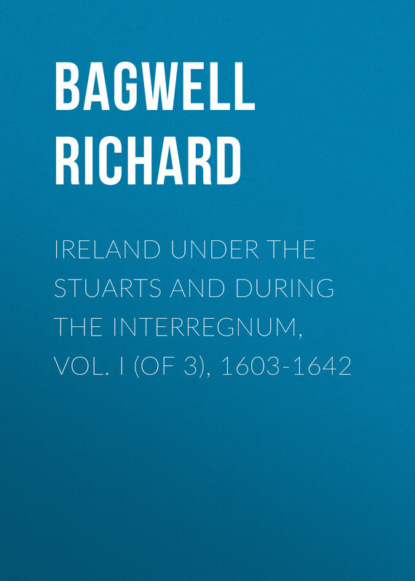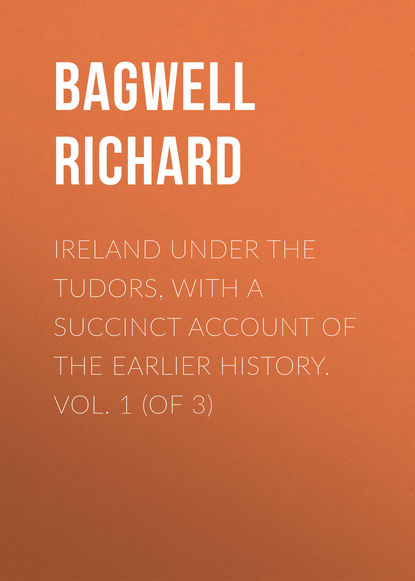
Полная версия
Ireland under the Tudors. Volume 3 (of 3)
87
Maltby to Walsingham, June 17, 1582; Wallop to Walsingham, June 21; Walsingham to Grey, June 25; Lady Desmond to Burghley, August 28; Lords Justices to the Privy Council, October 12; Four Masters, 1582; O’Daly.
88
G. Fenton to Walsingham, November 5, 1581. In a letter to Walsingham of July 2, 1582, Grey complains that Burghley listens to slanderers; the Queen’s opinion, &c., July, No. 76. The sword was delivered August 31.
89
Spenser’s View of the State of Ireland. This is one of the many passages tending to prove that the original shamrock was the wood-sorrel, and not the white clover, which could never have been edible; consult Bentham’s British Flora under Oxalis, and see below note to chapter 52. St. Leger to the Queen, March 12, 1582, to Burghley, April 20; Justice Meade to Walsingham, May 28. The soldiers were nearly as badly off as the natives, Dowdall to Walsingham, April 24. In the relation of Lord Grey’s services (September 1582) is mentioned ‘the general destruction of the enemy’s churls.’ The churls were the non-combatant country folk.
90
Grey to the Privy Council, April 12, 1582; to Walsingham, May 7; a friend to Mrs. Nugent, July 5, 1583; Sidney’s Brief Relation, 1583. Sir Robert Dillon, who succeeded Nugent as Chief Justice, was much blamed for his conduct in this case; see his letter to Walsingham, June 25, 1582.
91
John Nugent’s confession, February 5, 1582; petition to Burghley, September (No. 85); Ormonde to Burghley, May 30, 1583; Janet Nugent’s petition, August 30; warrants for the remission of her fine and for restoration to her property, April 18, 1584. It is stated that the fine was imposed on the information of John Cusack. William Nugent left Ireland in or before January 1582.
92
Grey to Walsingham, May 7, 1582; Mr. Rawley’s opinion, October 25. Ormonde’s appointment was announced on December 3.
93
The Bishop of Ross to the Lords Justices, October 9, 1582, with remarks by the Lords Justices; Auditor Jenyson to Burghley, September 4; St. Leger to Burghley, September 22, and to the Lords Justices, September 26; the Portreeve of Cashel to the Lords Justices, September 28.
94
Letter from Onor Cartye enclosed in one from the Lords Justices to Walsingham, October 3, 1582; St. Leger to Burghley and Walsingham, September 22.
95
Maltby to Walsingham, June 21, 1582; Clanricarde to Maltby, July 7; Fenton to Leicester, August 13; to Walsingham, August 23. The award is in Carew, under November 17.
96
Barnaby Gooche to Burghley, August 27, 1582; Justice Meade to the Lords Justices, October 13; Lord Justice Loftus to Burghley, November 5; Lords Justices to Burghley, December 8; Spenser’s State of Ireland.
97
St. Leger to Fenton, October 31; to the Queen and to Burghley, November 26, 1582; Burghley to Loftus and Fenton, and to St. Leger, December 9; St. Leger to Burghley and Walsingham, February 2, 1583.
98
Earl of Ormonde’s demands, &c., November 1582; Walsingham to Wallop, December 6; Burghley to the Lords Justices, December 8; Rate for 1,000 men to be sent into Munster, December 15; Lords Justices to Burghley, January 5, 1583; Ormonde to Walsingham, January 27; Wallop to Walsingham, February 7 and March 6; Minute for the Lords Justices, March 5; Ormonde to the Lords Justices, March 20. Ormonde left London, or Windsor, December 22, and landed at Waterford (viâ Milford) January 21, having been long hindered by storms.
99
St. Leger to Burghley, Oct. 29, 1582, and Jan. 16, 1583; and to Walsingham, Feb. 11.
100
G. Fenton to Burghley, Feb. 24, 1583; Ormonde to the Privy Council, Feb. 28 and April 5; to the Queen, April 24; to the Privy Council and to Burghley and Walsingham, May 28; to the Lords Justices, June 15; to the Queen, June 18; to Walsingham, June 22; Thomas Mynne to Wallop, April 9.
101
G. Fenton to Walsingham, Jan. 16; St. Leger to Walsingham, Feb. 11; Sir W. Stanley to Fenton, May 25; Desmond to Ormonde, June 5; Ormonde to Burghley and to the Queen, June 18; to Burghley, June 22.
102
St. Leger to the Queen, May 8 and Aug. 5 (the latter was intercepted); to Burghley, Aug. 5 and Oct. 19; to Walsingham, Aug. 5, 1583, and Sept. 14, 1584; Ormonde to Burghley, Oct. 20, 1583; to the Privy Council, Jan. 23, 1584; to Burghley, Jan. 26, 1584; Walsingham to Ormonde, March 25 and June 12, 1583; Lords Justices to Walsingham, June 18, 1583; G. Fenton to Walsingham, May 30, 1583. The tone of all Wallop’s and Fenton’s letters is unfriendly to Ormonde.
103
Ormonde to Burghley and to Walsingham, July 10, 1583. The nobles and gentlemen who came to Ormonde at Cork and gave pledges were as follows: – Earl of Clancare; Lords Barrymore, Roche, Kinsale and Lixnaw; Sirs – Thomas of Desmond, Owen MacCarthy Reagh, Owen O’Sullivan, Barry Roe, Lord Lixnaw’s son Patrick, the White Knight, Patrick Condon, the seneschal of Imokilly, Cormac MacDermot, nephew to Sir Cormac MacTeig, Callaghan MacTeig MacCarthy, brother to Sir Cormac MacTeig, O’Sullivan More, Donell, nephew to Sir Owen O’Sullivan, O’Donoghue More (inhabiting in MacCarthy More’s country), O’Donoghue of Glenflesk, MacDonogh MacCarthy of Duhallow, O’Keefe, MacAuliffe, O’Callaghan, MacFynnyne, William, brother to the Knight of Kerry, Thomas Oge, seneschal of Kerry, Donogh MacCragh (a rhymer), and divers captains of gallowglasses of the MacSwineys and the MacSheehy’s.
104
St. Leger to Burghley, Aug. 5 and Oct. 19, 1583; N. White to Burghley, Aug. 24; Ormonde to Burghley, Sept. 4 and 23 (the latter enclosing Lord Roche’s letter); Privy Council to Ormonde, Sept. 19.
105
I have followed the strictly contemporary account printed by Archdeacon Rowan in the Kerry Magazine (Jan. 1854), and reprinted by Miss Hickson in Old Kerry Records. No other account is so full, and it is easily reconciled with the Four Masters and with Ormonde’s letters printed by Mr. Gilbert in vol. iv. of the Irish National MSS, and see Ormonde to Walsingham and Burghley, Nov. 28, and Smith’s Cork.
106
The spot where Desmond fell is on the right bank, rather low down in the glen. No doubt the cabin where he spent the night was higher up. In the survey made by Sir Valentine Browne and others, and privately printed by Mr. S. M. Hussey, is the following passage: ‘A great wood here and there, filled with oak-trees fit for house timber, but not large enough for the making of ships and castles. But the greater part of the said wood consists in underwood of the age of fifty and sixty years, filled with dotted trees – ash, hazels, sallows, willows, alders, birches, white-thorns and such like… The wood is called Glanageenty, in which the late Earl of Desmond was slain in his rebellion, containing in length about four miles, and in breadth two miles, which said woods, because no woods there are saleable, and they lie under the mountains of Slew-Logher, far from any river or navigable stream, are here valued at nil.’ I inspected the ground in June 1883.
107
Birch’s Memoirs, i. 27; Ormonde to Burghley, Jan. 26, 1584; Lords Justices to Ormonde, Dec. 31, 1583.
108
Second examination of Christopher Barnewall, Aug. 12, 1583.
109
The text is taken from the official correspondence, Lords Justices to Robert Beale, Oct. 8, 1583; to Walsingham, Oct. 20, Dec. 10, March 7 and 8, 1584, April 14, and July 9; Walsingham to the Lords Justices, April 28, 1584. It appears from the Catholic accounts that combustibles were poured into the boots. That of the Jesuit Holing, who died in 1599, may be taken as contemporary; it is printed in Spicilegium Ossoriense, i. 87. ‘Tormenta nova illi parantur; nam ejus pedibus atroces hæreticorum ministri ocreas, butiro, oleo, et sale oppletas, ac – quod longe crudelius fuit – crudo ex corio conditas subjecerunt; postea, vero, catenis simul et compedibus alligatum, aperto in loco, nempe in medio castri – ubi spectaculum mundo, hominibus, et angelis – ubi ab omnibus videri potuit, lento igne apposuerunt, illicque detinuerunt, donec ipso corio consumpto, butiro, oleo, et sale ferventibus, ossa non cute pro carne tecta verum etiam omnino munda fuerint relicta… Postea in ergastulum et obscurissimum carcerem reducitur, et post sex menses tanquam traditor et reus criminis læsæ majestatis, ab iniquo judice ad mortem condemnatus est. Ad extremum, post inaudita tormenta et carceris molestias, albescente cælo, ne forte tumultus fieret in populo qui ejus exemplo, doctrina, et constantia permotus ad ejus defensionem perveniret, ignorantibus civibus patibulo suspensus martyrium consummavit Dublinii circa annum 1585, mense Maio.’ Other accounts, which agree in essentials, are collected in Brady’s Episcopal Succession, ii. 11, 599. The Valicellian MS. there quoted, says a withen rope was used to protract his agony; but Bacon tells us that this kind of halter was generally used in Ireland, and that a rebel objected to any other.
110
Ormonde to the Privy Council and to Burghley, Jan. 11, 1584, with enclosures; Wallop to Walsingham, Jan. 21.
111
John Browne to Hatton and Walsingham, Nov. 19, 1583; Clanricarde to the Privy Council, Jan. 31, 1584; Lords Justices to the Privy Council, March 28, 1584; Wallop to Leicester, Jan. 26, 1581, in Wright’s Elizabeth. The Four Masters bear out Browne’s statement as to John Burke’s popularity; see also a damaged paper calendared under Nov. 1583 (No. 99). The Earl’s pardon passed the Irish Council, June 28, 1584. Lady Mary married O’Rourke. ‘That honest woman,’ Bingham wrote some years later, ‘is deceased in childbirth’ (to Gardiner, June 10, 1589).
112
Lords Justices to the Privy Council, Sept. 12, 1583. Fenton to Leicester and Warwick, Sept. 13, in Carew; Hooker. This is one of the last, if not the very last trial by combat in the British Islands. Lord Reay’s case, in 1631, is in Howell’s State Trials, vol. iii., with a minute account of the ridiculous ceremonies proper to such a mode of trial; but in that case the fight did not actually take place.
113
Reasons of Brian MacGilpatrick O’Connor &c. (translated out of Irish), Oct. 15, 1583. The brothers seem to have subsided, or as some would say risen, into farmers.
114
The memorial of the Privy Council and the Queen’s instructions are both printed in Desiderata Curiosa Hibernica; see also Perrott’s Life, and Ormonde to Burghley, March 13, 1584. Perrott landed at Dalkey, June 9, and was sworn in by Loftus in St. Patrick’s on the 21st.
115
Ormonde to Burghley, March 13, 1584 (from Carrick); docquet of letter, April 4; Ormonde to Burghley, May 19 (from Abermorles); June 4, (from Carew).
116
Order for a hosting, June 22, 1584; Wallop to Walsingham, July 9; Fenton to Walsingham, July 10.
117
Henry Sheffield to Burghley, July 12, 1584; Memorial for Mr. Edward Norris, Aug. 6; Bingham to Burghley, Aug. 7.
118
William Johnes to Walsingham, July 14, 1584.
119
Perrott’s Memorial for Mr. Edward Norris, Aug. 6, 1584.
120
Wallop to Burghley, Sept. 17, 1584; to Walsingham, Oct. 14 and Dec. 4; Sir V. Browne to Burghley and Walsingham, Oct. 18; to Walsingham, Dec. 11; Waterhouse to Walsingham, Nov. 28; Lord Thomond to Burghley, July 14, 1585; Vice-President Norris to Perrott, Dec. 30, 1585.
121
Fenton to Burghley, Aug. 19, 1584; Perrott to the Privy Council, Aug. 21; Bingham to Walsingham, Aug. 30; John Norris to Burghley, Oct. 16.
122
Walsingham to Hunsdon, Aug. 24, 1584, in Wright’s Elizabeth; Privy Council to Perrott, Aug. 31; Perrott to Privy Council, Sept. 15.
123
Perrott to Privy Council, Sept. 15 and 17.





